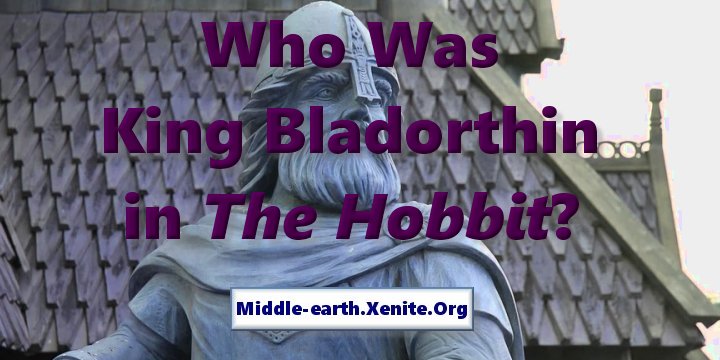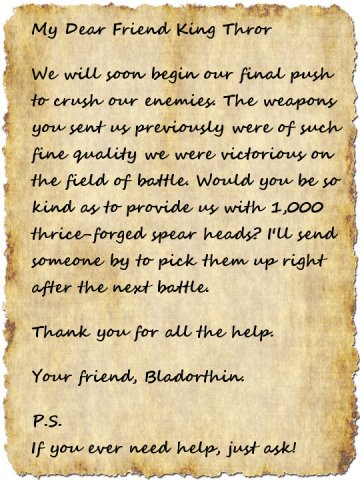
Q: Who Was King Bladorthin in The Hobbit?
ANSWER: One of the most compelling mysteries of The Hobbit is the identity of the long-dead king Bladorthin, for whose armies an untold number of spears were “thrice-forged” but never delivered. People have been asking who King Bladorthin could have been, since The Hobbit shares very little historical information and since The Lord of the Rings does not mention him while discussing the brief histories of Dale and Erebor.

Many Tolkien scholars turn to early drafts of The Hobbit for help because when Tolkien first began to develop the story he named the wizard (who would later be known as Gandalf) Bladorthin. Typical arguments suggest that Bladorthin must be an Elvish construction contemporary with Tolkien’s languages from the early to mid-1930s. In The History of The Hobbit John Rateliff argues extensively that Bladorthin is probably Elvish, but there is no textual support from Tolkien himself regarding the etymology of the name.
However, if we assume for the sake of discussion that the early, early Hobbit story really did involve a wizard with an Elvish name, such an assumption cannot preclude or rule out an equally valid assumption that Tolkien might have found a better use for the name after he transferred it to another character with a different role, function in the story. Neither assumption can be proven conclusively and it may be that appealing to Occam’s Razor (which says that “it is futile to do with more things that which can be done with fewer”) is our only recourse for suggesting a more satisfactory and plausible guess (but it can only be a guess).
Rateliff compares Bladorthin/Gandalf to the wizard Artaxerxes from Roverandom and the wizard Tuvo from “Gilfanon’s Tale” in The Book of Lost Tales. Artaxerxes enchanted a toy dog, Roverandom, who went on to enjoy many adventures. Tuvo, according to Gilfanon, awoke the Elves and became their first king; he was a powerful wizard. Another of Tolkien’s wizards who resembled the interloper magician was Father Christmas. Rateliff makes the case that Tolkien reused the theme in many stories, and it is reasonable to accept that this is so.
But Tolkien reused many ideas and themes to tell new stories. Hence, his mythology for England was supplanted by the Silmarillion mythology, which in turn was supplanted by the Middle-earth mythology, in which elements that owed their beginnings to The Book of Lost Tales could still be found. It is therefore reasonable to accept that when Tolkien changed Bladorthin to Gandalf and then introduced a new Bladorthin, he was giving the new Bladorthin a different purpose, albeit a brief one with no real indication of any broader significance than that which appears in the story itself.
As Rateliff shows clearly in The History of The Hobbit, the story was originally set in Beleriand or lands adjacent to it, somewhat contemporary with the adventures of Beren and Luthien. But Tolkien subsequently revised the story to remove the suggestions that the Hobbit was close to Beleriand in either time or geography. We do not, therefore, need to assume that Bladorthin was of any particular race or that his name should have been closely associated with any specific language of the evolving world.
We can, however, look at the name as something that Tolkien simply liked. Artaxerxes is certainly not an “Elvish” name — it is ancient Persian. Tuvo may be a Spanish or Dravidian word. Tolkien expressed a love for the sound of Spanish and he also had at least some knowledge of Dravidian through his study of the reconstructed proto-IndoEuropean language. (For more about a possible Dravidian connection, see “Who Were The Variags of Khand?”.)
If Tolkien was wont to name his wandering wizards from historical languages, then it follows that Bladorthin might also owe something to a language of Tolkien’s association. This would not necessarily conflict with John Rateliff’s assertion that “Bladorthin” is “clearly Gnomish (or perhaps Noldorin)”. Some words in Tolkien’s constructed languages may be found in historical languages. Tolkien might have borrowed those words in order to explain names he had devised which he wanted to use.
Bladorthin could have an Anglo-Saxon (Old English) etymology derived from a combination such as blaed (“blade”) and (?)orthin(gas) (“people of (?)orth”). For example, the town of Worthing was originally named Worthingas, the followers or people of Worth. However, this idea has failed to capture the popular imagination.
Another Old English word, blaed, means “leaf” (or “leaf-like part” referring to a sword or similar bladed shape). It has been suggested that orthin could be related to “eorthe”, meaning “ground, soil” or “the material world”. Bladorthin could therefore mean “blade of the world” or “sword of the world”. Old Norse would have used blad to refer to herbs and plants, which could be associated with magic. Hence, Old Norse jordh (“earth”) might be a possible root for the name as well: (magical) herbs/plants + earth.
Although we cannot explain the origin of Bladorthin’s name, people have tried to determine what the significance of his spears might be. Described as “thrice-forged”, many readers have mistaken the reference to their heads for a three-pronged spear head (such as adorns a trident). However, “thrice-forged” seems only to be a reference to quality. Steel can be reforged to make it stronger. In fact, in the late 1800s James Baldwin wrote a book on northern European mythology in which he shared the story of how the young Siegfried forged a sword named Balmung three times.
An interesting connection between Baldwin’s story and The Hobbit is that young Siegfried (a prince) is sent to study under the great warrior-smith Mimer by his father, because smiths were believed to wield great power. Thorin tells Bilbo that fathers used to beg his people to teach smith-work to their sons. Baldwin even suggests that Mimer might be connected with the ancient dwarf-folk who once ruled the land. At this point if you know anything about The Silmarillion and the story of Turin Turambar, you may be thinking of the dwarf Mim.
Some Finnish folk songs also mention “thrice-forged” things which may be magical in nature. Hence, it seems that Bladorthin’s spears (or their thrice-forged heads, at least) may owe something to Norse/Germanic/Finnish mythology and folklore. We cannot, of course, deduce why the spears were never delivered, although one could suppose they were not necessarily the first shipment.
The simple truth is that Bladorthin’s name sheds no light on his race or origin. Tolkien was clever and knowledgeable enough to see the connections between various languages but he didn’t need to be so elaborate or contrived. He could simply have liked the sound of “Bladorthin” and chose to keep it in the story after he gave the wizard character the new name of Gandalf.
If it could be shown that Bladorthin’s name was strongly connected to the Old Norse language then that might suggest that the name was retained for the purpose of expanding the very slight history of Dale (or nearby lands) ever more slightly. Regrettably, we will have to wait until some additional linguistic or textual information comes to light, if such exists. We may never really know who King Bladorthin was.
See also:
# # #
Have you read our other Tolkien and Middle-earth Questions and Answers articles?
